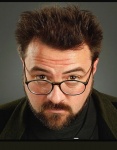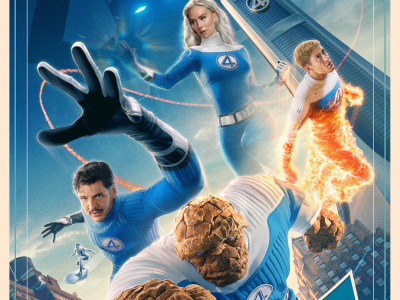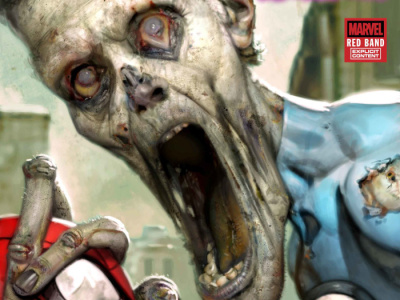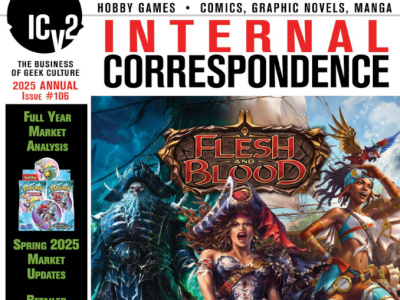
We caught up with famed filmmaker and writer Kevin Smith to talk about his plans for the Green Hornet miniseries he’s doing with Dynamite Entertainment (see “Dynamite Plans Three 'Green Hornet' Miniseries”). It's based on a screenplay he wrote for the Green Hornet feature in 2004. We talk about the genesis of the project, the creative process, and his approach.
Your movies have traditionally focused on the interactions between ordinary people. What attracted you to the bigger-than-life character of the Green Hornet and inspired you to write the original screenplay in 2004?
Well, in comic book format, that’s generally where I like to go hog wild and ape-shit. In movies, I’m kind of known for telling real world stories about blue collar people. When I’m in comics, it’s kind of like you’re in somebody else’s sandbox, you’re in the realm of the fantastic. It’s tough to do just navel-gazing when you can play with characters who are from other planets, you know, or dudes in masks who beat the shit out of people and are always unerringly correct, so that’s where I kind of cut loose and that’s what appealed to me about the Hornet--the notion of “Oh it’s like you’ve got a foot in both." It’s set in the real world that deals with all the physical laws of our world – to some degree – but it adds the element of the fantastic, a dude that's so hell-bent for what’s right that he’s willing to put his life at risk all the time, night after night, strap on a mask and go out and try to correct what he feels is broken. The hero story kind of appeals to, I don’t know about everybody, but certainly every boy, every man on the planet, we grew up hearing them and reading them and dreaming that we could one day be heroes of some sort, so naturally I’m attracted to it, even though it doesn’t seem like it would be in my wheelhouse based on the fact that I don’t do large, bombastic cinematic flicks. In comic books' world that’s where I go all
What sort of changes do you have to make to adapt a screenplay to a script for a comic book series?
Truthfully, all that was done for me. All I had to do was write the script, which I did years ago. Thankfully good old Phil Hester, who I worked with before on another Green book [DC's Green Arrow] that really worked out for us, is going to be following me on this book, so he actually made the time that I didn’t to do breakdowns and he did visual breakdowns, like I didn’t have to take the script--my idea of breakdown would have mean taking the script and turning it from this 120 page script into a panel by panel, page by page broken down script. That would have taken a long time and time that I really didn’t have at that moment to devote to the project. Phil, since he was following me, said “Hey man, I can do it.” And he took my script and broke it down into panels, which is enormously helpful right off the bat.
Essentially what Phil did is kind of what Joe Quesada did for the first issue --maybe even the first two issues--of Daredevil. The first two issues of Daredevil I didn’t write the script, I just wrote a synopsis, and then Joe went crazy and drew the book and then I would dialogue to it, kind of the “Marvel Method” to it and then after that I got my feet under me and I would write full script. And when I say outline, the outlines were very large and they did have lots of dialogue, but they weren’t full scripts. So then I started writing full script and as a full scriptwriter, you write everything. You write page one panel one, you have to describe every thing you want seen in that panel, then write the dialogue for it, panel two, panel three, panel four, sometimes I’d get up to panel eight per page and then you do the next page, panel one, panel two, it’s a lot of work.
When you’re writing a comic book from scratch it’s not a lot of work because you’re just laying it out as you’re writing. When you’re trying to do it from something that’s already been done it’s kind of tough. It’s really tough. So Hester did essentially what a storyboard artist would do. He broke the whole thing down into a series of images which was enormously helpful. It allows us all to step back and look at the layout of the book from issue to issue, see where your issues are going to end and where they are going to pick up in the next book, see how much information, are we going to have widows (a/k/a cut off info that would be better in one book or another but not straddled between two) so Phil did a lot of back-breaking work.
At that point Jonathan Lau comes in and realizes the book, which is not to say Hester’s done all the work for this dude. I’ve seen Hester’s breakdowns, they’re great but they’re limited, it’s done, sketches at best--very quick, cartoony drawings. So I’m sure that Jonathan’s going to go into a very much more Jonathan Lau-type direction with his artwork so that’ll be the next step. When he does that then I’m going to take my script which Phil has broken down and use those two sources against the artwork and then go “Okay, this dialogue can stay, or I’m going to rewrite this dialogue or hey, we don’t need this dialogue or I’m going to move this or, in some rare cases, we need to use another image, let’s do this, let’s insert this, blah, blah.”
So literally, much like you’re being a writer/director in a movie, you’re also the editor so you’re really involved in three steps. Yes, you did the initial script and Phil is visualizing it initially but you’re involved in the process of making sure that you feel it works. You’re adding in scenes that weren’t in the script and at the same time then you’re proofing it one last time to give any feedback again.
Yeah, I’m kind of adding the title of the producer of the book if you had to figure out an overall role, to some degree.
Your movies always contain some very humorous elements, and it’s hard to imagine that your Green Hornet script didn’t as well--is it difficult to transfer those funny bits to the comics?
I don’t know, it’s just something, I love to do the type of humor I do but I’m not an idiot, you have to know your audience. Sometimes it’s appropriate and sometimes it’s not. I’m not going to run up to my mother and scream “c********r” in her face, I’m just not. So based on that, I’m certainly not going to do that in Green Hornet. This is based on a script for a PG-13 franchise that Miramax was trying to start. They were going to spend about $70 - $80 million to make it. They didn’t want my foul-mouthed antics on display, they wanted the other thing that I do, just dialogue to some degree, or performance, not the visual aspect, at least not then. Not at that point, not in 2004 when I wrote it.
How did you treat the “Black Beauty”? Did you provide it with any new capabilities?
No, I didn’t really "fetishize" the Beauty that much in the movie. Number one, I remember the big issue was “Hey, who’s going to do the car?” and I had to sit down and meet with a bunch of different car people. So before I locked in on anything specific the car could do, they wanted me to meet with a car company and figure out which one it was going to be before I wrote that into the script. That was what was kind of off-putting to me about the whole process. I met with merchandisers, toy people, potential licensees, licensors, car people and even the Air Force because they had a “Hornet” jet, all before I wrote a single word. They were platforming the f**k out of this thing.
When you make a movie of that size you don’t just make that movie, you’re making all the merchandise, because you’re setting up a potential franchise and that’s what they were going to do with it. So that to me was intimidating as well where I was like “Oh, I don’t know man. I don’t know if I can handle this franchise myself and I don’t know if this franchise has a chance to exist in the way they want it to exist,” so it was intimidating to that degree. When I finally sat down to write the script (and at that point I had bowed out of directing it), I called Harvey [Weinstein] and said “Look, this is too big for me dude.” I said, “Thank you but I’m going to pass now.” And
So when I did write it I didn’t really go crazy with the car but I did... There was an idea that came actually from Joe Quesada because at one point, I said “Joe, you want to direct this Green Hornet picture with me?” and he was like “WHAT!?” and I said I’m not good at visuals, we could storyboard the entire thing and we can co-direct, you take care of the action I’ll take care of the dialogue and character stuff. Naturally that went away because we ended up not making the movie at all let alone making it with somebody else. But Joe had an awesome idea about the car, taking the car from just a car to something else (without ruining it). The car, at the end is Joe’s call and it was actually before Dark Knight, which was nice. In terms of in the Dark Knight the car becomes something else.
Do you make use of the gun that sprays “knock out gas,” or the debilitating “Hornet’s Sting” sound weapon from the TV series?
Not the sound weapon. I definitely use debilitating gas but I’ve been doing that my whole life, badum bump. I’ll be here all week.








